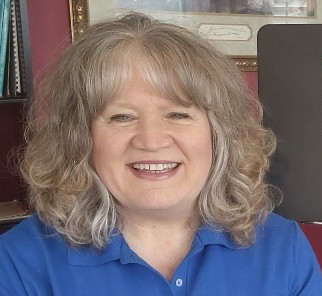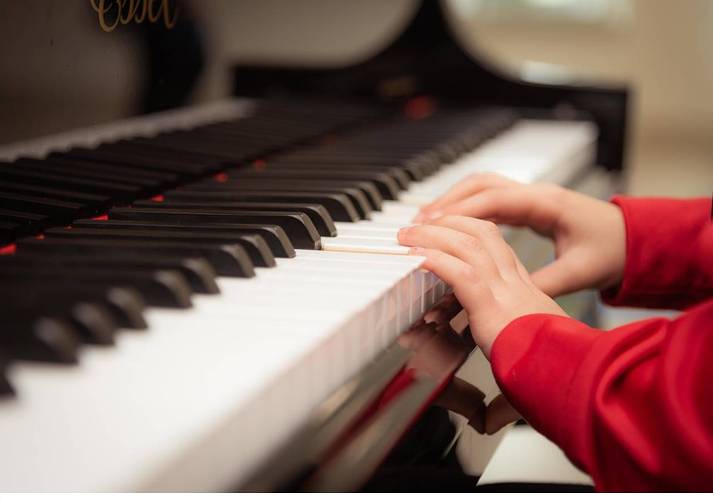Tip #7 – Singing or playing an instrument requires proper technique. Improper piano technique can prevent the pianist from attaining their potential and may cause injury. I will be highlighting bad piano techniques and how to fix them!
#1 Sitting Too Close and Too Low
Most pianists, even professional pianists, often sit too close and too low to the piano. Sitting this way causes the hand, wrist, and arm to be in an incorrect position, possibly causing pain and tiredness after prolonged playing.
Correct Piano Technique: Knees at Edge of Keys
Your knees should be aligned with the edge of the keys and your elbows in front and not beside your body. For the height, your waist should be level with the keys. For children, have them sit on something (a phone book is perfect for this). The wrist should be flat, not lowered, making your hand, wrist, and arm level. Having a low wrist puts pressure on it and makes the fingers do all the work, causing them to tire quickly. A lowered wrist may also cause carpal tunnel, pain, and numbness in the fingers. Sit tall (don’t slouch) at the front edge of the bench, which gives you a forward angle that helps when needing to play with force, using gravity to assist in playing. Sitting on the edge of the bench doesn’t apply to children if their feet cannot touch the floor.
#2 Fingers too Flat or Too Curved
One bad piano technique I’ve seen is the wrong positioning of the fingers, from being too flat to having too much of a curve. Some method books describe the position of the fingers as though you’re holding a ball. The problem with this concept is the fingers will be naturally tense.
Correct Piano Technique: Relaxed and Rounded Fingers
Your fingers should be as relaxed as possible. For a beginner, relaxing is not the easiest way to play, but it gets easier with skill. The simplest way to having a correct finger position is to place them palms up on your lap and let your fingers relax. That is the EXACT way to hold them on the piano. Imagine the rainbow curve, which is the exact curve needed. Play using the pads of the fingertips, not above the first joint (too low) or the part just below the fingernail (too high). Also, keep the first joint from bending. Unfortunately, pianists can never have long fingernails; otherwise, it will hinder playing at the correct part of the fingertip.
#3 Moving Hands and Arms Too Much
If you’ve ever watched someone playing piano on TV (which we know they’re not really playing), they will usually move their hands and arms way too much. Moving unnecessarily may cause you to play incorrect notes, especially when playing quickly, and tire more easily. Moving the hand up and down is never needed. A technique called “rolling the wrist,” is where the wrist is lowered for stressed notes and raised for lighter notes. This kind of motion, in my view, is unnecessary and may make it difficult to play quickly and accurately.
Correct Piano Technique: Little to No Movement
The goal of playing the piano is to keep your arms and hands as still and “quiet” as possible. The composer Mozart was known for placing a coin on the student’s hand while playing, with the goal to keep it from falling off. I’ve had fun doing this with my students as well. The fingertips should be “glued” to the keys, only going down and using the weight of the fingers to play the keys.
With that said, there are some movements that help when playing. One movement is pivoting left or right towards the notes you’re about to play. Another is positioning the hand towards the back of the piano to accommodate the black keys, especially when the shorter fingers (the thumb and pinky) play the black keys and longer fingers play the white keys. And finally, another movement that is an exception to the fingers staying glued to the keys is raising the entire hand for staccato and accented notes or playing loudly. Raising the hand to play the keys gives momentum and strength.
Good Piano Technique is Critical!
Having good piano technique helps the pianist play the very best. It also helps with the physical aspect of playing the piano to prevent tiredness and pain. You, the piano instructor, can help your piano students play well, not despite their technique, but because of it.
I hope this tip helps you be the best piano teacher EVER!

Kathi Kerr founded Melody Music Studios in 1989, a nationwide music instruction studio. In 2017, she founded an independent publishing company called Melody Music Publishers for piano and singing method books. The learning model is small steps using drills and repetition, how students think and learn.

